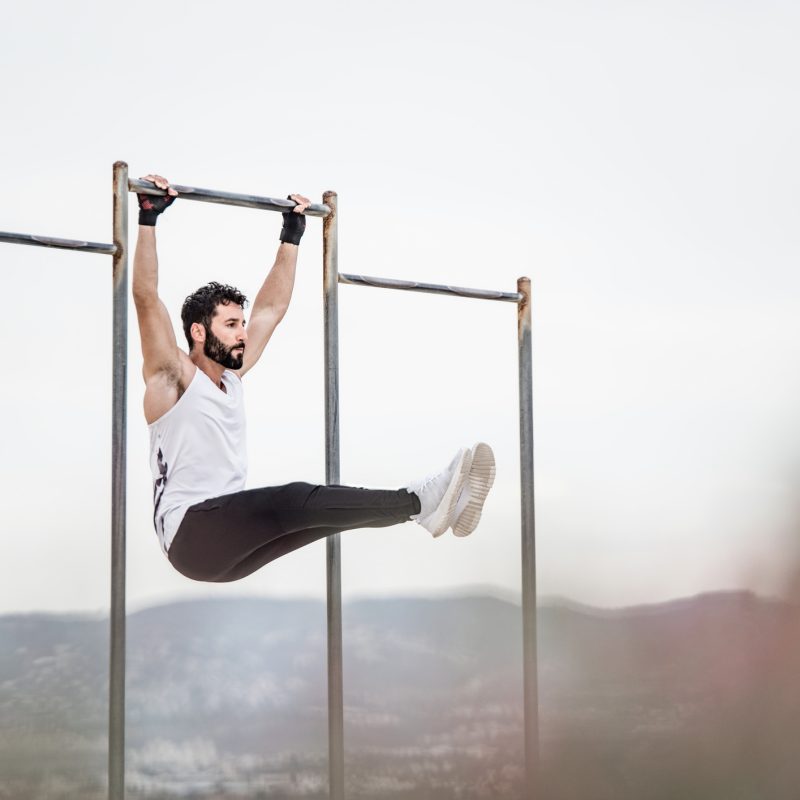
We all know those clients: they insist that only hours of cardio and hundreds of crunches will reward them with crop -top-worthy abs. Perhaps personal trainers can entice these clients to “train smarter, not harder” by introducing them to the hanging leg raise. While definitely a challenging move, this exercise incorporates trunk flexion, core stability, shoulder strength and stabilization, and ranks among the best abdominal exercises in the book. Read on to learn more about the specific advantages this move can offer.
Letting It All Hang Down
Most personal trainers will agree that the majority of suspension-related exercises found in any gym will elicit a measurable amount of shoulder strength. Even if clients did nothing more than hang vertically from a high bar for 20 or 30 seconds, their deltoids and core will gain strength and stability. Hanging leg raises confer advantages simply not achievable with a traditional abdominal crunch.
In contrast to sit-ups, crunch variations, or rope flexions, hanging leg raises provide more of a challenge to the body. While sit-ups and crunches may take their toll on the delicate cervical vertebrae if one’s form veers off-center from perfect alignment, hanging leg raises ensure that the ribcage and thoracic region do not lose their position of extension. Consider the power involved in hanging from a bar while calling upon only the core to pull muscular (i.e., heavy) legs upward toward the chest. In the absence of swinging/momentum, the hanging leg raise remains one of the few trunk flexion movements that works entirely from the bottom upwards; it taps directly into those hard-to-access deep abdominal tissues which lie from the belly button down to the pubic bone. This exercise forces the client to maintain good posture while eliminating strain on the neck and thoracic vertebrae.
More Than Just the Abs Get into the Game
“Hanging leg raises primarily work the hip flexors and the abdominals, and are a great addition to any fitness routine for overall spine health, core strength and mobility,” says Mitchell Fischer, ACSM, personal trainer and weightlifting coach. “You get additional benefits of working your grip and shoulder strength by hanging from the bar and stabilizing your body throughout the movement.” Fischer adds that in addition to the abs and hip flexors, the hanging leg raise also recruits the quadriceps, using them to lift the legs.
One research team investigated the activation/work load placed upon the trunk muscles throughout certain abdominal exercises, specifically addressing the plank and bilateral leg raises. They observed that the horizontal body position held during a standard plank elicited significant activation within the internal oblique muscles, whereas the hanging bilateral leg raise revealed much more activation in the rectus abdominis region of the trunk. Both moves require the client to fully engage his core, as well as once again cultivating shoulder strength and stability.
Special Considerations
When assisting a client with the hanging leg raise, a personal trainer might want to pay attention to the amount of leg room in the area of the hanging bar; the client will need sufficient space in front of his body in order to safely lift and lower his legs.
Personal trainer Tatiana Lampa offers the following insight on hanging leg raises: “Focus on working the right parts of your body. Think about the contraction happening from your low abs”. One of the most common mistakes observed during execution of the hanging leg raise involved the innate desire to use momentum to swing up during the movement. Remind clients to hold onto this thought, and to instead focus upon engaging the core prior to lifting the legs.
Even at the bottom of the movement, keeping the legs slightly in front of the body always ensures a posterior pelvic tilt. This posture will keep the abdominal muscles activated while also protecting the muscles in the lower back.
By way of reminding a client to prioritize control throughout the move, suggest he try hanging by the bar first. This by itself does require a bit of strength and control. Stabilization from the high bar actually originates with the lats. Suggest that the client pictures himself “pulling” the bar toward his hips. Making sure he feels confident in this position prior to going any further will facilitate his understanding of the next challenging aspect of the hanging leg raise.
Make Modifications When Needed
If a client does not feel ready for this challenge, help him simulate the move by guiding him to perform reverse crunches while lying on a mat. He can then gradually work up to the hanging leg raise by trying bent-knee leg raises while lying on his back.
The next step involves assessing the client’s strength. If he labels himself on the weaker end of the fitness spectrum, most gyms offer straps that can assist in the hang. These “sleeves” attach to the pullup bar and provide support to the upper arms while performing the exercise. While hanging with the sleeves in place, have the client attempt to lift his legs with knees bent. This variation will feel a lot easier on his hamstrings and lower back. Using a captain’s chair as another alternative allows him to shift his torso weight onto his elbows rather than hanging from a pull bar.
Advanced Technique Variations
The hanging leg raise affords a personal trainer many ways to creatively increase the challenge for clients at a more advanced level of fitness. Consider adding a free weight (a dumbbell or kettlebell) between the client’s feet to increase hamstring activation while lifting straight legs.
The hanging L-sit, another popular variation, demands significant isometric strength and endurance throughout one’s core, hip flexors, and forearms. While suspended from a high bar, the client will lift his legs until they reach a parallel position to the ground, creating an “L” shape with his body. He will then attempt to remain in this position for a static hold as long as possible before lowering the legs.
Our final challenge position involves taking a hanging leg raise to the next level by extending the legs fully until the toes touch the bar overhead. This movement specializes in forcing the client to master momentum control, and ensures proper muscle engagement for stabilization throughout the exercise. The abdominal tissue in the lower part of the muscle (below the belly button) does extra work bringing the body to a position that amounts to “folding itself in half”.
Final Thoughts
When clients grow weary of the tedium associated with endless reps of crunches and sit-ups, offering a new challenge for the abdominal muscles will provide them with a multitude of benefits, from shoulder strength, forearm support, grip strength and momentum control to the mindset strength of learning to control the lower pelvic muscles required in the leg lift. It takes a bit of time to master, but the results certainly justify the hard work!
References:
https://pubmed.ncbi.nlm.nih.gov/30856100/
https://www.wellandgood.com/fitness/hanging-leg-raises
https://www.muscleandfitness.com/workouts/workout-tips/10-toughest-exercises-master/






